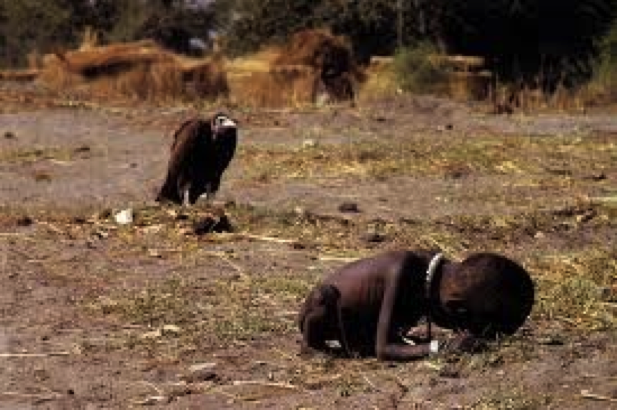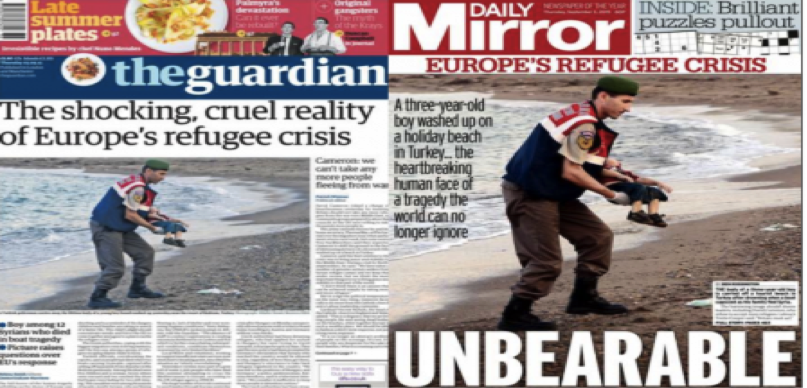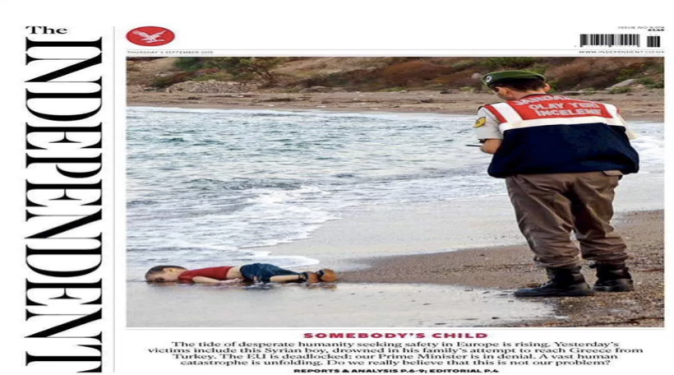Earlier this week in our tutorial we talked about whether an image should be censored or not, if so why should it be censored or why not? Will it affect the meaning and feelings behind the image or will it amplify the feeling behind them even more.

One image that has defiantly been a topic of conversation is the Sudanese photograph of the little girl who is being hunted by a beadily eyed vulture in the background.
This picture is really very symbolic of the greater struggle of famine that can be seen all throughout Africa. Most people know that there is not enough food and water in Africa, but still don’t contribute to the famine relief organisations. Famine is real in Africa and the African people need help.
Photojournalist, Kevin Carter, captured this particular photo. It pictures a struggling helpless child cowering as a vulture waits in the shadows for its long awaited prey. Carter won many awards for this picture, but in an interview that he did after this he revealed “ I was appalled at what they were doing, I was appalled what I was doing, but then people started talking about the pictures and I felt that my actions hadn’t been at all bad. Being a witness to something this horrible wasn’t such a bad thing to do”. Obviously his life changed dramatically after that hot dry Sudanese day in 1994. Three months later Carter, took his own life, as he could not live with the pressure of life anymore.
This all links back to what we discussed in class. Should the face of this little girl be censored or not? One of the big topics that was brought up after this photo was released in 1994; was it necessary for the face of this little Sudanese girl to be shown? If so, why? Would the photo have less significance if the image of the little girl was censored? Some people just say it is inhumane not to censor the image since it is of a little girl. There have been plenty of interpretations taken on this particular image, not to mention the two other images that we also discussed in the tutorial.


Alyan(Alan) Kurdi is a three year old Syrian boy who drowned after his boat capsized just off the coast of Turkey. This photograph sent shockwaves around the world. It is an interesting image to examine as after this happened, some newspaper companies decided to censor out Alyans face. However others like the Independent, decided not to. Is this an insult to Alyans memory? A member of the Turkish police found Alyan’s body. He was the man carrying Alyan’s body in all of the pictures that were published. So are these pictures that Susan Sontag spoke about in her book’ regarding the pain of others’ good images to look at or bad? Everyone has their own opinion about whether something is good or bad and it will always differ. But is there really such a thing as good pain? Especially when it involves young children who are in unfortunate situations like the two images that I have spoken about.
Bibliography
Heavyeditorial.files.wordpress.com. (2016). [online] Available at: https://heavyeditorial.files.wordpress.com/2015/09/aylan-kurdi1.jpg?quality=65&strip=all&strip=all [Accessed 3 Apr. 2016].
Iconic Photos. (2009). Vulture Stalking a Child. [online] Available at: https://iconicphotos.wordpress.com/2009/08/12/vulture-stalking-a-child/ [Accessed 3 Apr. 2016].
Pressgazette.co.uk. (2016). [online] Available at: http://www.pressgazette.co.uk/sites/default/files/styles/node_image/public/Screen%20Shot%202015-09-04%20at%2013.33.23.png [Accessed 3 Apr. 2016].
Sontag, S. (2003). Regarding the pain of others. New York: Farrar, Straus and Giroux.
YouTube. (2016). Death by Photography: A Kevin Carter Case Study. [online] Available at: https://www.youtube.com/watch?v=xDOxDRUNBBQ [Accessed 3 Apr. 2016].